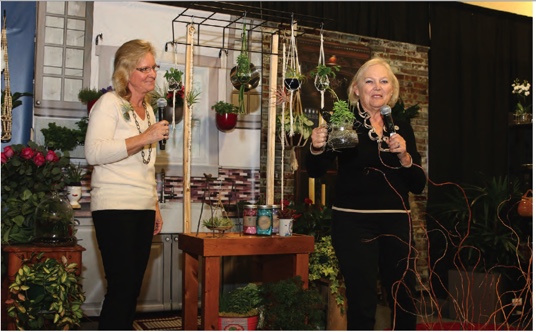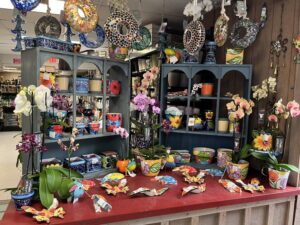
Adding the Heat of Tropicals
If your garden center is not already riding the indoor plant wave, now is the time to take the dive and expand your foliage and tropicals department. The interior plant boom continues as people can’t get enough “green” in their living and work spaces — and lives, in general.
Using data from its independent garden center clients from across North America, The Garden Center Group reports an overall 2.8% increase of all sales; tropical plant sales outpaced that representing 5.8% of total sales in 2018, which continues a three-year climb in sales for that category. Gains in tropical plant sales have grown an average of more than 20% in the past two years. Margins on tropical plants remain high.
People seek to balance their high-tech and virtual lives with a connection to nature. Houseplants, interior décor, living walls, green roofs, balcony gardens, plant pets and junglescaping are just a few answers to the call for nature.
Your tropicals department can be the “health and wellness” center for customers seeking happiness through plants.
Things to Consider
It’s important to think about your customers’ lifestyles when determining which foliage products to offer. Many consumers have moved from a DIY mindset to a Do-It-For-Me attitude. Rather than purchasing the various components to create a dish garden, they now seem to prefer leaving the store with a beautiful, finished product ready to either place in their home, give as a gift or show off on Instagram. No dirty hands, leftover parts or time spent on production — and they don’t mind paying more for the convenience.
Ready-made dish gardens, terrariums, plant décor, specialty arrangements and hanging baskets can be created by your team members and/or bought as finished products from a variety of wholesale plant companies.
For more traditional foliage plants, spend time checking out the many houseplant blogs available on the Internet to see which plants serious indoor plant enthusiasts are talking about.
Pinterest and Instagram are overflowing with plant photos, charts and information, indicating which varieties have already gone or are about to go mainstream. Currently, Monstera deliciosa is trending as a very hot choice. Not far behind are maidenhair ferns and Tillandsia xerographica. Go-to plants such as vining Pothos and flowering Spathiphyllum (peace lily) are now available in many variations.
Ask your wholesale supplier to provide unique air plants, larger-than-average succulents, and any plant your grandmother loved, as they are all coming back in vogue.
Begonias, sansevieria (mother-in-law’s tongue) and flowering kalanchoe were in demand by floral designers at the 2018 American Institute of Floral Designers (AIFD) Symposium. These designers are the influencers to consumer trends. Of course, the exotic, colorful and low-maintenance qualities of bromeliads and orchids make them plants, which never go out of style.
Don’t Forget the Upsell
You can also add plant enhancements to your tropicals department. Natural elements such as moss, small stones and pebbles, mini tree branches with lichen and seeds and pods are very popular with today’s consumers. Stylish decorative containers are a must.
Garden centers do well to place plants and decorative pots near one other. Encourage customers to mix-and-match plants and containers until they find the combinations which they love best. In addition to traditional pots, include macramé hangers and fabric containers.
So, Where Do I Find the Plants?
So, how do you find the various foliage plants your customers want? One of the best resources for tropical foliage and connecting with the people who know everything about interior and tropical plants is the Tropical Plant International Expo (TPIE). TPIE is an industry trade show produced by the Florida Nursery, Growers and Landscape Association (FNGLA). It takes place each January in Fort Lauderdale.
Not only are there 400-plus plant-connected vendors to see, but also TPIE offers pre-show nursery tours and high-level, often complimentary, sessions highlighting consumer trends as they relate to plants, design and retail.
TPIE is a must-attend event for any company owner (or manager) who wishes to enhance and generate more profit from their company’s tropicals department. Visit TPIE’s website, www.tpie.org, to search exhibitors and view coverage of the 2019 event.
Plant Shipping Options
There are various types of companies through which to purchase plants as a wholesale buyer. Buying directly from the grower is an excellent option. Although there are exceptions, most growers specialize in certain types and varieties of plants.
Nurseries typically post or regularly send out updated plant availability lists to indicate the specific varieties and sizes which are ready to ship. In most cases, the buyer arranges for the shipping if the plants are being delivered by common carrier or via the buyer’s own truck.
Some items are also suitable for FedEx or UPS shipment. Both of these couriers offer Bin Solutions programs, such that anything which fits within a certain size bin can be delivered via ground shipment. The customer is charged by the bin, not by individual items.
Plants may also be purchased through wholesale foliage brokers located in foliage growing areas — typically Florida and California. These companies specialize in collecting a wide variety of plants from many nurseries, consolidating orders and often helping to arrange for shipping and delivery. Brokers use their close proximity to the nurseries and their own plant expertise to stay up-to-date on availability and quality control.
RELATED: Tips from the Garden Center
Wholesale florists and flower markets provide another option for foliage purchases. These companies are typically located in urban centers, closer to the buyer. They purchase truckloads of plants from the wholesale growers, often using their own trucks to ship from Florida. These plants are then made available to wholesale buyers, typically on an as-needed basis. While their selection of plants may be more limited, this is a convenient method to purchase plants for small or infrequent orders.
The shipment of plants varies by location, size, timeliness needed and temperature factors. Several trucking companies provide temperature-controlled trucks which may be needed seasonally in areas where temperatures inside the truck rise above or below the plants’ ideal temperatures. Most of these companies offer LTL (Less Than [a Truck] Load) services, with specifications and pricing varying by company.
Expect shipping schedules to be much tighter in the spring than other times of the year. Because several stops are incorporated with LTL deliveries, this is a service to use when there is flexibility related to delivery dates and times.
Buyers with their own trucks have the most flexibility in terms of picking up plants from growers. Increasingly, growers are investing in packaging to box plants and finished products securely to ship via couriers. This allows growers to service small orders through ground or overnight delivery. Temperature considerations are important for items being shipped by courier.
Early attempts are being made to offer Uber-like, on-demand trucking services for all types of freight on a national level. These start-up companies use cloud-based platforms and mobile apps to match freight loads with truck fleets or owner/operators who are both available to haul the load and can meet other qualifications. It may not be far in the future when buyers, sellers and freight carriers merge in the cloud to move plants from the wholesale nursery to the garden center.
If ever there was a time to expand and enhance a garden center’s tropicals and foliage department, it is now. Based on everything from social media content, consumer trendspotter reports to increased wholesale and retail foliage plant sales, the people- plant connection will only grow.



















 Videos
Videos





